| Author |
Message |
Luka Borscak

|
 Posted: Sat 02 Oct, 2010 6:01 am Post subject: Hanwei Saxon Posted: Sat 02 Oct, 2010 6:01 am Post subject: Hanwei Saxon |
 |
|
I preordered Hanwei Saxon about a month ago from KoA, and few days ago it arrived at last. I will let the pictures do most of the talking, but I just want to say that while it certainly is pattern welded and the core is made of three damascened rods plus edges, the steels used seem to be very similar or same so they used some dark compound and "painted" it over one steel and not over the other to achieve the effect that would in period be achieved with etching and different steels or iron reacting differently when etched. Handling is not the best as the sword is quite heavy and most of the heaviness comes from the very thick blade with not much distal taper. Sword is wieldable because it's relatively short but it could use some distal taper for more agility. Overall I am pleased with the sword because KoA's price is really low compared to others and with this piece I wasn't going for a high performance sword and it looks very nice, pattern is beautiful (the photos don't do it justice, they are taken with my phone) although achieved with a bit unconventional method. The hilt isn't really great but it does look like more or less typical type L but I will probably rehilt the blade with nicer and more historically accurate fittings.
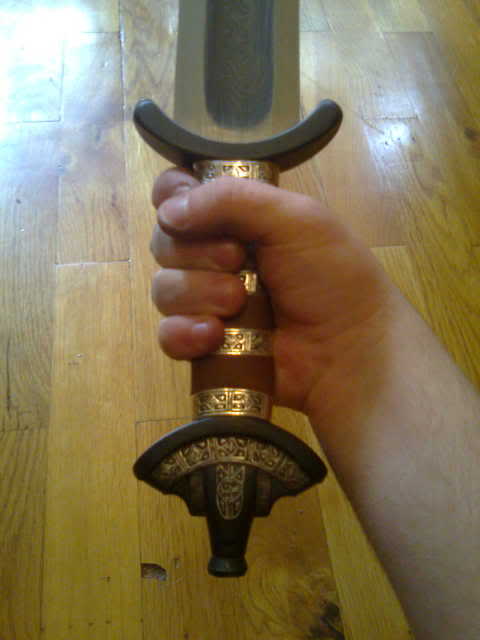
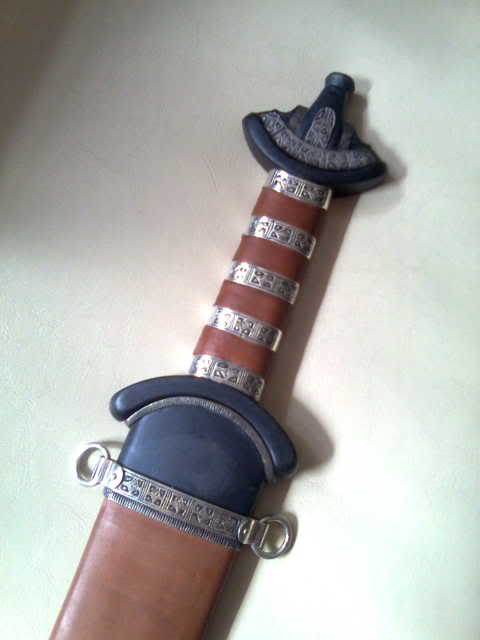
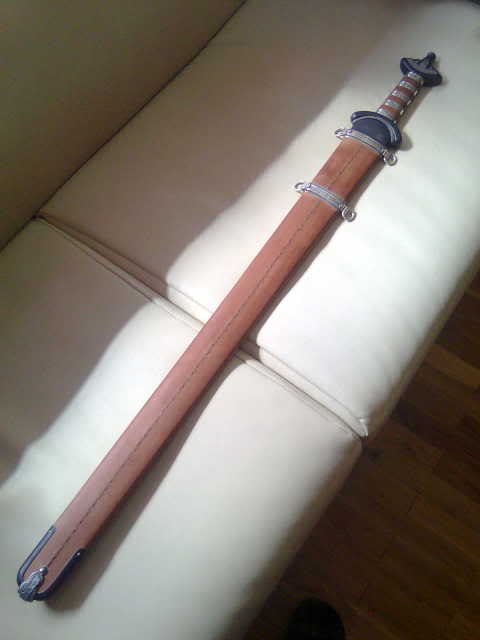

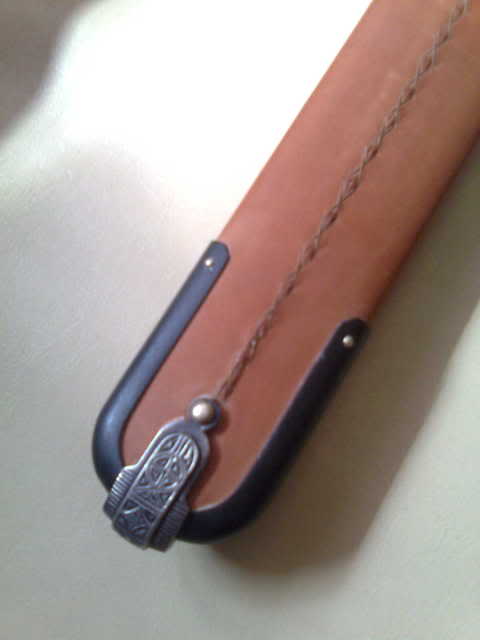
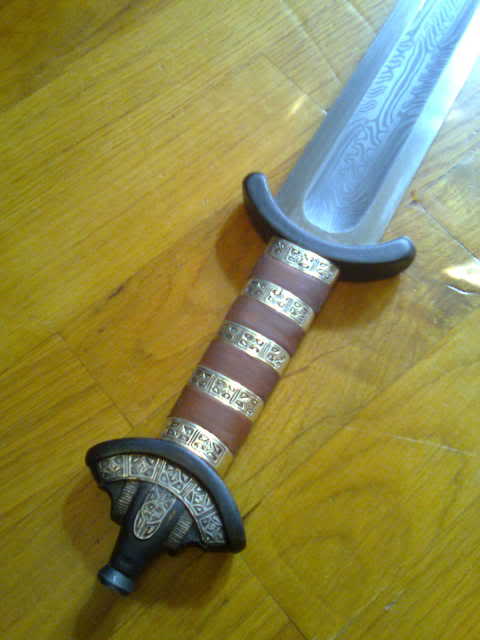
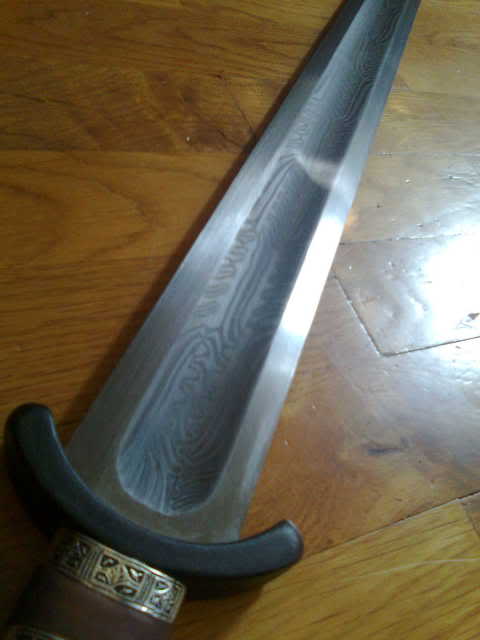
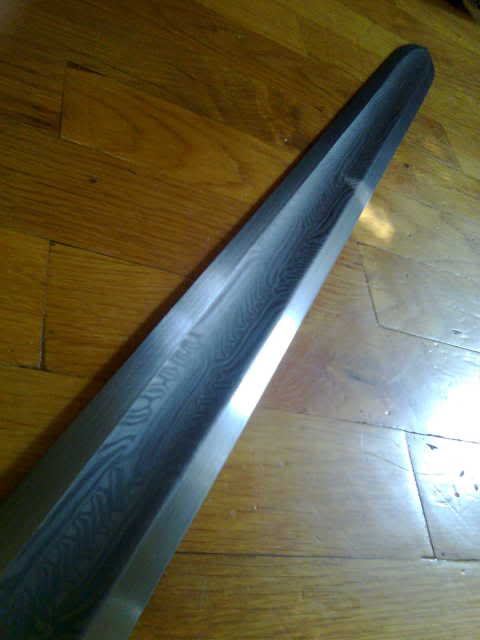

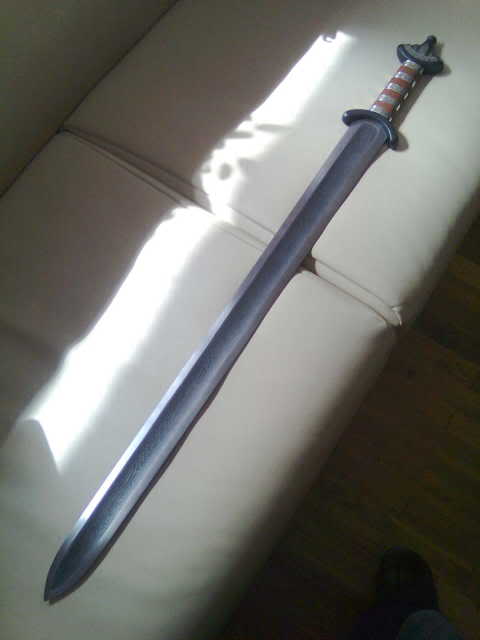
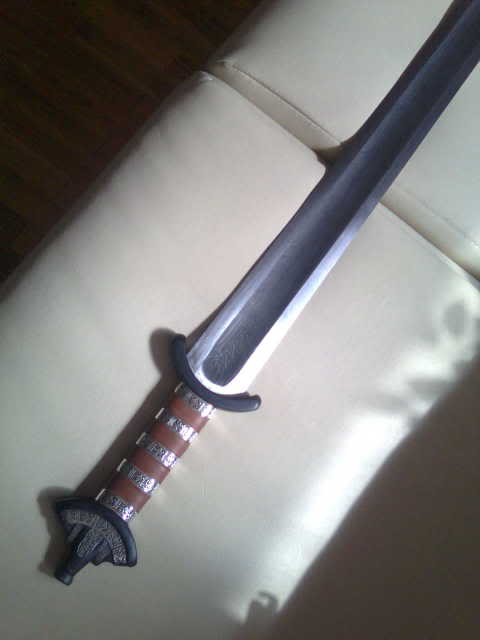
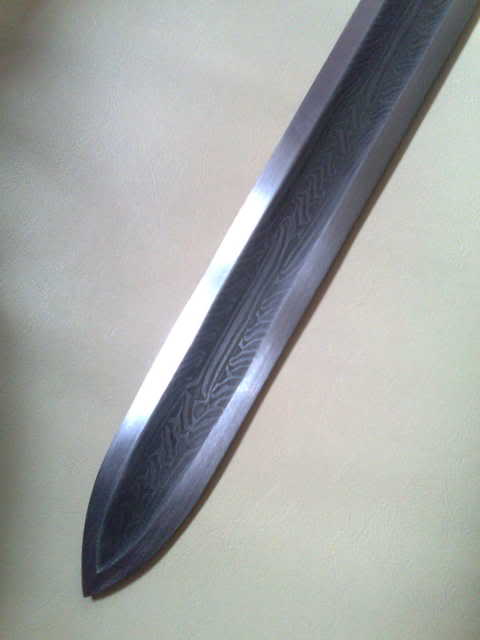
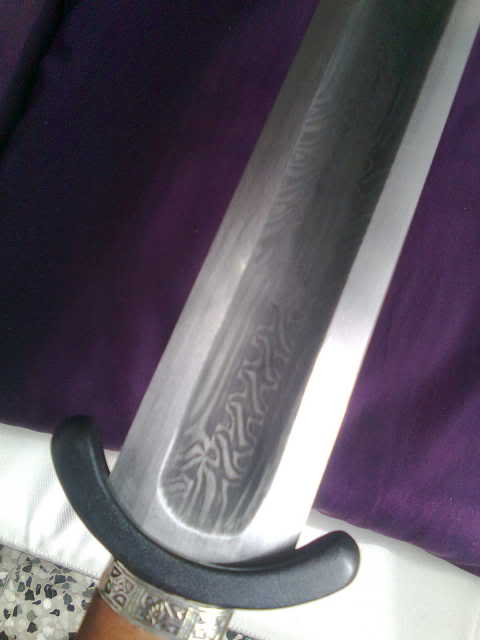
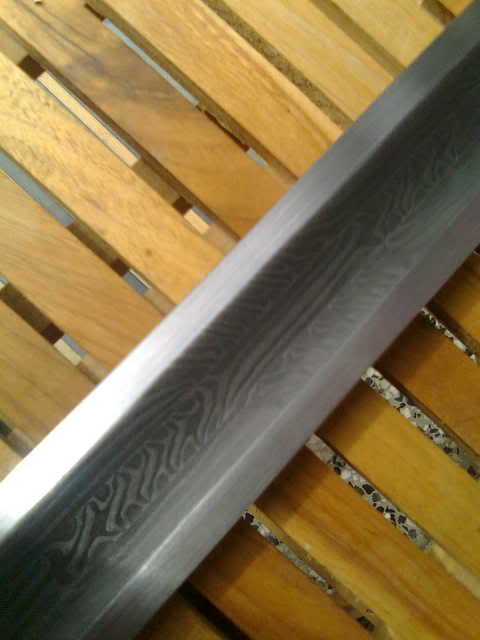
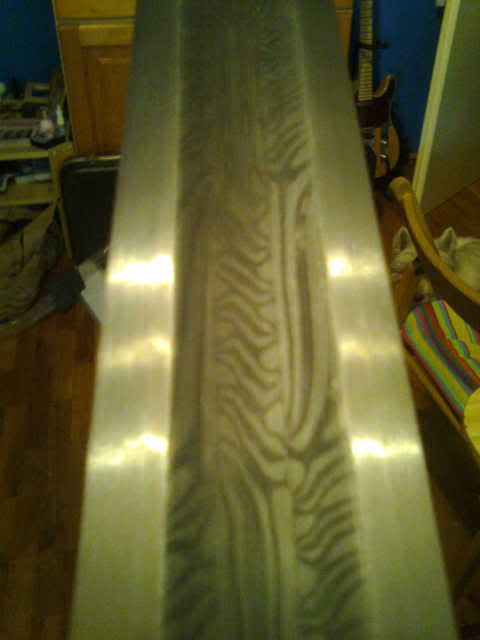
|
|
  |
 |
Paul Hansen

|
 Posted: Mon 04 Oct, 2010 12:22 pm Post subject: Posted: Mon 04 Oct, 2010 12:22 pm Post subject: |
 |
|
|
Just to be clear: is the sword actually pattern welded in this pattern? So did they make this sword with three pattern welded rods with the edges welded on?
|
|
  |
 |
|
Dan P
Location: Massachusetts, USA Joined: 28 Jun 2007
Posts: 208
|
 Posted: Mon 04 Oct, 2010 4:56 pm Post subject: Posted: Mon 04 Oct, 2010 4:56 pm Post subject: |
 |
|
|
That handle looks way too big. Blade sure is nice though especially if it really is pattern weld.
|
|
  |
 |
Luka Borscak

|
 Posted: Tue 05 Oct, 2010 2:53 am Post subject: Posted: Tue 05 Oct, 2010 2:53 am Post subject: |
 |
|
The grip is 4 inches. I just have miniature hands. 
The blade really is pattern welded with 3 twisted rods in the core and two more rods for the edge but the pattern can't be brought out with etching only because you can see the lines of different steels but not any different color for the color contrast. so they darkened one steel with something and left the other more naturally colored. I might be misinterpreting something but I think it is like I think it is. Anyway, the sword really is pattern welded, you can see the welding lines between the rods and even between two steels in each of the three damascened rods.
|
|
  |
 |
|
Peter Lyon
Industry Professional
|
 Posted: Tue 05 Oct, 2010 10:41 am Post subject: Posted: Tue 05 Oct, 2010 10:41 am Post subject: |
 |
|
If you want the hilt to be historically accurate there is no need to rehilt, unless it is to make the grip more comfortable, as this is a copy of the Gilling sword which is housed at the Yorkshire Museum in York, England; it is (from memory) 8th century. I got to see the original close up and this is a good copy, apart from the centre prong of the pommel maybe being a little long. Even the grip seems the right width, maybe a little thicker than the original, which only has the bands surviving, so the core material has to be speculative.
Still hammering away
|
|
  |
 |
|
Joel Chesser
|
 Posted: Tue 05 Oct, 2010 3:46 pm Post subject: Posted: Tue 05 Oct, 2010 3:46 pm Post subject: |
 |
|
I like the hilt fittings. If i were to do anything to it i would be to shorten the grip a bit and i'd want a longer blade
..." The person who dosen't have a sword should sell his coat and buy one."
- Luke 22:36
|
|
  |
 |
|
Timo Nieminen
|
 Posted: Tue 05 Oct, 2010 8:01 pm Post subject: Posted: Tue 05 Oct, 2010 8:01 pm Post subject: |
 |
|
A comparison:
Hanwei Saxon Sword: Blade 68cm, grip 4", about 20% profile taper.
Gilling sword: Blade 69cm, grip 8.3cm, thickness at guard appears to be 6.7mm thick (somewhere from 6.6 - 6.8 mm), about 20% profile taper. Maybe about 30% distal taper? Hard to measure from the drawing, and the blade is corroded.
Fuller on the Gilling sword goes under the lower guard; this is the biggest visual fail on the Hanwei sword. Size is close, grip is too long, but not outrageously so.
"In addition to being efficient, all pole arms were quite nice to look at." - Cherney Berg, A hideous history of weapons, Collier 1963.
|
|
   |
 |
|
Viktor Abrahamson
|
 Posted: Tue 05 Oct, 2010 11:20 pm Post subject: Posted: Tue 05 Oct, 2010 11:20 pm Post subject: |
 |
|
The "dark paint" can be made if you put the patternwelded metal in vinegar over night.
I have done it on knives to see where/how my patterns ended up before grinding the blade.
|
|
    |
 |
Luka Borscak

|
 Posted: Thu 07 Oct, 2010 8:56 am Post subject: Posted: Thu 07 Oct, 2010 8:56 am Post subject: |
 |
|
| Peter Lyon wrote: | | If you want the hilt to be historically accurate there is no need to rehilt, unless it is to make the grip more comfortable, as this is a copy of the Gilling sword which is housed at the Yorkshire Museum in York, England; it is (from memory) 8th century. I got to see the original close up and this is a good copy, apart from the centre prong of the pommel maybe being a little long. Even the grip seems the right width, maybe a little thicker than the original, which only has the bands surviving, so the core material has to be speculative. |
Yes, I found the picture on the Yorkshire Museum page and this one does look like a good copy! But the original was probably two piece pommel. I will leave it as is for now, maybe when I have enough money I will get a really nice type H hilt for it because I really love type H hilts and with it I would probably like this sword even more.
|
|
  |
 |
Luka Borscak

|
 Posted: Thu 07 Oct, 2010 8:59 am Post subject: Posted: Thu 07 Oct, 2010 8:59 am Post subject: |
 |
|
| Timo Nieminen wrote: | A comparison:
Hanwei Saxon Sword: Blade 68cm, grip 4", about 20% profile taper.
Gilling sword: Blade 69cm, grip 8.3cm, thickness at guard appears to be 6.7mm thick (somewhere from 6.6 - 6.8 mm), about 20% profile taper. Maybe about 30% distal taper? Hard to measure from the drawing, and the blade is corroded.
Fuller on the Gilling sword goes under the lower guard; this is the biggest visual fail on the Hanwei sword. Size is close, grip is too long, but not outrageously so. |
The blade of the Gilling sword looks much more tapered then the Saxon, but distal taper would be most useful for handling of the Saxon... It's quite thick and with very little distal taper...
|
|
  |
 |
Luka Borscak

|
 Posted: Thu 07 Oct, 2010 9:00 am Post subject: Posted: Thu 07 Oct, 2010 9:00 am Post subject: |
 |
|
| Viktor Abrahamson wrote: | The "dark paint" can be made if you put the patternwelded metal in vinegar over night.
I have done it on knives to see where/how my patterns ended up before grinding the blade. |
I'll sure try it if the current pattern ever fades too much...
|
|
  |
 |
|
|

